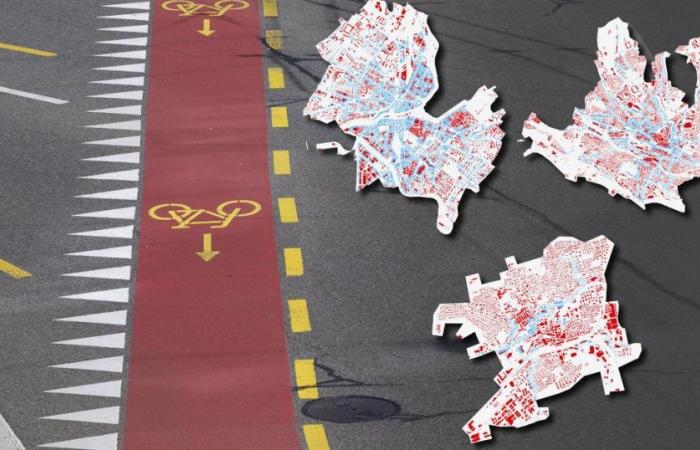Cycle lanes and paths struggle to make room on most French-speaking roads. Geneva is an exception according to data collected by RTS.
Riding a bike in the city is not easy. Between vehicles brushing against the handlebars, avoiding doors or crossing overcrowded intersections, there are many pitfalls. Add to this the regular absence of cycle lanes and you have an environment that is not very friendly to cyclists.
Unpublished data on cycling facilities in the six French-speaking capitals show that most towns lack cycling infrastructure which covers the majority of their territory.
External content
This external content cannot be displayed because it may collect personal data. To view this content you must authorize the category Infographics.
Accept More information
The comparison of two-wheel facilities and roads is clear: in five out of six cities, the bicycle network is three to eight times shorter than all the roads. Only Geneva stands out with 126 km of cycle lanes for 204 km of roads, or a density of 62%. At the bottom of the ranking, we find the two capitals of the Jura Arc. The space provided for cyclists only represents 22% of the total roads in Neuchâtel and 13% in Delémont.
External content
This external content cannot be displayed because it may collect personal data. To view this content you must authorize the category Infographics.
Accept More information
The city of Sion does not do much better with 27% of cycle lanes compared to roads. A figure that does not delight the Sedun authorities. Christian Bitschnau, vice-president of the municipality, concedes that the Valais capital is a “bad student, but which works a lot to improve”.
According to him, Sion has been investing considerably for several years in its bicycle network and this is work that takes time, particularly to obtain the necessary authorizations.
The place of the bicycle is evolving
Christian Bitschnau also talks about a change in mentality towards soft mobility. “The Valaisan loves the car, but the new generation is more looking for the right means of transport for the right occasion. We try not to pit the different modes of transport against each other.” A desire shared by the vice-president of Pro Vélo Suisse Delphine Klopfenstein Broggini: “the solution is not to eliminate the car, but to redistribute public space in favor of active mobility”.
The bicycle has for a long time suffered from a lack of space on the roads and consideration in mobility policies. “We saw it as a leisure activity, as a sport,” explains Patrick Rérat, professor of geography at the University of Lausanne. “For example, Neuchâtel is a very pleasant city for leisure cycling, with summer rides along the lake. On the other hand, for utility cycling such as commuters, we notice that the infrastructure is lacking.”
External content
This external content cannot be displayed because it may collect personal data. To view this content you must authorize the category Infographics.
Accept More information
Needs specific to each city
The mobility expert also emphasizes that not all cycling arrangements are equal. Cycle lanes painted on the road or sharing the roadway with buses do not offer all the safety guarantees for comfortable travel, unlike paths, which are separated from motorized traffic.
For Delphine Klopfenstein Broggini, comparing the length and type of facilities between municipalities is necessary, but it is also necessary to take into account the environment around cycling infrastructure. The number of vehicles and the speed allowed on a section also contribute to cyclists’ feeling of safety.
In small towns, the lower density of road traffic makes it possible to avoid the implementation of sometimes costly bicycle facilities. Delémont admits that the development of its network for two-wheelers is behind schedule. To overcome this, the authorities are focusing in particular on cohabitation in the city center between vehicles, bicycles and pedestrians, with zones limited to 20 km/h or 30 km/h, without cycle lanes or paths.
Across the four corners of French-speaking Switzerland, cities still have work to do to offer safe cycling facilities adapted to different forms of mobility. The Confederation has announced that it wants to double cycle traffic by 2035. An objective that the current network cannot support.
Cyrille Gay-Crosier
TV subject: Camille Rivollet
Radio subject: Romain Bardet






